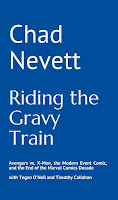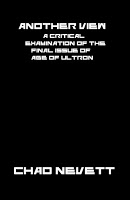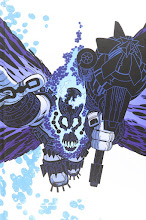(
Note: the use of "/" in quotes is meant to show where speech balloon breaks occur. Also, all quotes seek to copy what appears in the comic as faithful as possible, so capitalization, italics and bold are all as they appear in
Codeflesh.)
It's not often these days that you come across something that makes you sit up and take notice because of its uniqueness. Most of the ways to make comics have been done already and all we get left are variations on those. But in the final chapter of their book
Codeflesh, Joe Casey and Charlie Adlard did something new with the form and it showcases just how skilled both are, and just how much potential comics have as a form.
In simple terms, the story is a music video in the form of a comic, but that's a big simplification. Instead of regular dialogue, narration and sound effects, every word of the issue was part of a letter written by the main character, Cameron Daltrey. Every speech balloon, caption and sound effect continues the letter. But what's more is that the art reflects a regular story and the actual placement of word balloons and sound effects actually suggest that Casey wrote those scenes out normally and then replaced what was written with the letter. It is the starkest juxtaposition of prose and art that I've seen where it wasn't simple text with spot illustrations. The closest thing we've seen so far is overlaying captions on a story, but somehow the two, while appearing similar in nature, only cross paths in the most superficial manner.
In the majority of stories that have used a juxtaposition of captions and pictures, the technique is broken up with dialogue within the story or it is done simply through captions, which suggests a distance between the text of the captions and the pictures. This is especially true in cases where the text in the captions are quotes from other works (a poem, for example). What makes what Casey and Adlard did in that final chapter of
Codeflesh so unique is the integration of the narration into the story. As I said, it appears as if a regular
Codeflesh story was produced and then all of the dialogue was replaced with the contents of the narrating letter.
This technique brings to mind music videos where often the same technique is used: the song and lyrics replace the actual words spoken by the people within the story of the video. The best example I can think of that showcases this is the video for "We Are All Made Of Stars" by Moby where the video cuts between various scenes where various people all lip-sync to the song. The visuals tell a story, of sorts, while the fact that the people in the video speak the words of the song causes a correlation to be formed between what you hear and what you see.
In the final chapter of
Codeflesh, this is done in a unique way as the story is not a self-contained story, but the conclusion of a larger story, so it is able to accomplish much of what it does because of the reader's familiarity with what has gone on before. While this may seem like a failing, all this means is that Casey and Adlard chose a smart manner in which to attempt this "music video" technique. This is something that easily could have failed miserably, but partly because of its use in the eighth and final chapter of the story, it works incredibly well.
The story of
Codeflesh is of Cameron Daltrey, a bail bondsman who specialises in giving bonds to superpowered criminals, a group that is likely to attempt to skip out on their bail. He does this so he can hunt them down and bring them back in. At some point before the series begins, Cameron was ordered by the court to stop doing that himself and since that time he has dressed up in a costume to disguise his activities with only his partner Staz knowing what he does. This, of course, causes a strain in his relationship with his girlfriend Maddie in the classic Peter Parker mould. In the final chapter of the story, Cameron writes a letter to Maddie in which he attempts to explain everything and this letter narrates the story.
The first indication we get of the "music video" technique is on the second page where in the first panel, the phone rings and instead of a standard sound effect, the text used is "SONG AND" which continues the letter begun on the previous page and leads into Cameron answering the phone with "DANCE THAT WE'VE ALWAYS BEEN THROUGH," and so on (Casey 112). The fact that the technique is first used with a telephone ringing sound effect and features the word "song" may be a coincidence, but it just seems strangely appropriate.
On the next page, we are given a scene where one cop is discussing the vigilante he's seen, who we know is Cameron in disguise, and within the scene there are a few panels that taken by themselves work rather well with the dialogue of the letter. This is probably the most unique effect produced by the technique: pictures that when taken out of context seem to work with the dialogue of the letter. The best example in this scene is the final panel on the page where the cop is being mocked by the other cops and has this sort of pouty/annoyed look on his face while he says "FOR THAT MONEY SO I TRACKED HIM DOWN IN ENCINO AND BROKE TWO OF HIS / GODDAMNED
TESTICLES AND, YEAH, HE LOST AN EYEBALL. BIG FUCKING DEAL, RIGHT?" (Casey 113). The picture of the cop coupled with that last bit of dialogue almost seems to mimic how Cameron looks while speaking of the incident.
The next effective juxtaposition takes place two pages later where a large, superpowered criminal returns home and in the final panel of the page, we see his head sticking up into the attic and he says in a quiet voice "WITHOUT THE
JUDGE THROWING MY ASS IN
JAIL" which works just perfectly as this criminal is going to skip out on his bail (Casey 115). In the following pages, Cameron fights with the criminal until he finally subdues him, but sustains injuries to his legs. He then calls Staz and the context of the picture narrative and the letter narrative work well together again, as he says on the phone almost immediately "PRETTY FUCKING
BRILLIANT, RIGHT?" to which we then see Staz respond with "ANYWAY, I CAN ALREADY HEAR IN MY HEAD WHAT YOU'RE GOING TO
SAY . . . /
'CAMERON, COULD YOU BE A BIGGER ASSHOLE?! THIS IS FUCKED UP!'" (Casey 118-119). While the text doesn't match up exactly, the general feeling is almost perfectly matched in a strange way.
The final and best example of the interplay between words and pictures is in the second-last scene of the chapter, which takes place as Maddie is at her job as a stripper. She is doing her job and one of the customers gets a little rowdy and tosses some beer on her, and she responds by kicking him in the face (as his head is about level with the stage she's on). She then proceeds to yell at him and the text used just works so well, as it expresses both what Cameron wants to tell her and what we believe is what she ultimately wants to tell him, but can't because of his behaviour. The text she yells at the customer is "
PLAIN AND SIMPLE, /
I DON'T WANT YOU OUT OF MY /
LIFE." (Casey 121). This is the climax of the story, I believe as it is where the two stories intersect the strongest and after that, it is just a gradual slowing down.
The story ends with Cameron alone in his office after he has crumpled up the letter. He does this after he writes the line "And if us being together means I have to give up the job, then I guess I" (Casey 122). This is an interesting way to end the story as it shows just how addicted Cameron is to his secret life, but it also undermines the narration we've just read. Even though we didn't see the letter sent, we assume that while we read it, Maddie is also reading it and that we will be given a happy ending of sort. By having Cameron discard the letter, Casey and Adlard destroy that assumption, but also give us a more powerful story.
The ultimate achievement of the story is that while there is a connection between the words and pictures at some points, for the most part, there is a total divide between the two, but the reader never has any trouble following the story told in pictures. Often, readers and creators forget just how visual comics can be and this story proves just how important pictures are in storytelling. In a manner, this is essentially a silent story, the likes of which Marvel attempted to do a few years ago, but it also isn't like those stories because of the use of word balloons. The fact that word balloons are there suggest to the reader that a conversation is happening, along with who specifically is speaking and roughly, how much they are saying. This almost causes the reader to create dialogue in their heads for what is being said, but without actually doing it consciously. This is a strange trick, as the combination of what the pictures convey through body language along with the size and type of word balloons give the impression of a conversation that the reader unconsciously creates and assists them in understanding the visual story.
I hope I'm explaining all of this right. It is difficult as this technique relies heavily on the visuals, and I'm left only with words that show up on some computer screen. Hell, I haven't even been able to come up with a name for the technique besides "music video". It really is unique and complex. Half of the stuff I mentioned here I didn't even notice until I began working on this essay. What Casey and Adlard did in that final chapter of
Codeflesh is new and that's rare in comics today. I hope other look at what they did and try to do it again, if only so we can see if it is a technique that will work outside of this one case. People are always talking about comics as movies, but comics as music videos just seems as relevant. Even the length of the story (12 pages) captures the music video feeling more because it is short, while the so-called "movie comics" usually end up in the 88 to 132 page range, so perhaps that will be a requirement for any future applications of this technique. Nonetheless, the final chapter of
Codeflesh is a unique storytelling experience that, as far as I know, hadn't been seen in comics previously (and knowing my luck, that will be proven wrong five minutes after this essay goes up).
Work Cited
Casey, Joe and Charlie Adlard et al.
Codeflesh. San Francisco: AiT/Planet Lar, 2003.






